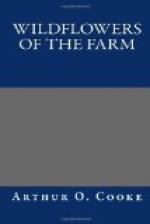If you and I were clever gardeners and had plenty of time and patience, we could get purple or nearly white wallflowers from these yellow-flowered plants upon the wall. It would perhaps take us many years, but we should succeed at last. This is how we should set about it.
Suppose that we wished to have a Wallflower nearly white. We should look carefully along the wall in spring, when the blossoms are out, until we found the very palest yellow blossom we could see. We should mark that plant, and when the flower was over and the seed was ripe, we should collect the seed. Among the plants grown from this seed we should choose again the plant that had the palest flowers, and should save the seed from that. We might have to go on doing this for twenty years or more, but in time we should have a Wallflower so pale as to be almost white.
Quite white we should never get our Wallflower, for no pure white flower can be obtained from a yellow one. However pale our Wallflower might be there would still always be just a tinge of yellow or cream colour in it.
If, on the other hand, we wanted a purple or a very dark brown Wallflower, we should save seed from those blossoms which were nearest to the colour we wanted—dark brown or with a tinge of purple in them. We should sow seed from the darkest blossoms again and again, and at last we should get what we wished to have.
[Illustration: Red valerian.]
[Illustration: Stinging nettle.]
[Illustration: White dead nettle.]
Besides choosing seed from the lightest or darkest blossoms, we should tend our plants very carefully and well, giving them plenty of good rich soil. This would make them grow bushy and with many flowers, as we see them in Mrs. Hammond’s garden beds.
Many of our garden flowers have been produced in this way, by selecting and improving wild flowers. Of course all flowers grow wild somewhere; some in England, but many more in foreign countries, where the air is warmer and the soil richer and better. The Pansy is a little English wild flower with yellow, blue, and red petals. From this little flower gardeners have produced large and beautiful pansies of many different colours and shades of colours—white, yellow, blue, and brown. This has been done by careful selection, just as we spoke of doing with the wallflowers.
But if the large single-coloured pansies of which I have told you, or Mrs. Hammond’s dark brown wallflowers, were allowed to seed themselves—that is, were allowed to drop and sow their own seed year after year—do you know what would happen? They would gradually revert or turn back to their original form and colour. The flowers would become mixed in colour and less fine in size; at last they would be simple wild flowers again.
[Illustration: Pansy.]
Now it is June, and the blossoms of the Wallflower have faded and fallen. The old wall is, however, growing gay with another plant—the Red Valerian. We must be careful to remember that it is the Red Valerian, for there are other valerians. There is the Great Valerian which does not grow on walls or rocks, but in damp and shady places; its flowers are pale pink.




